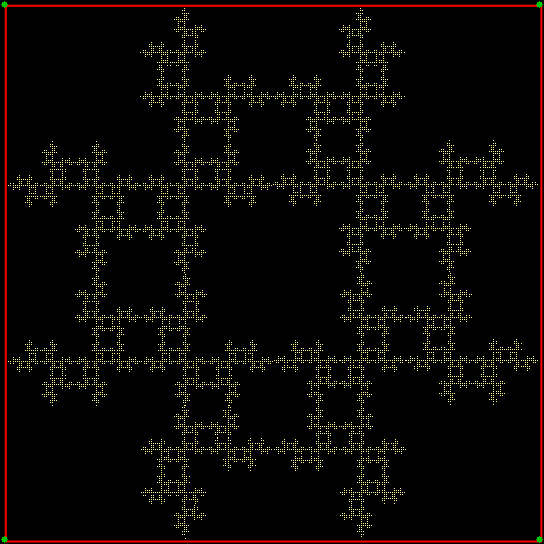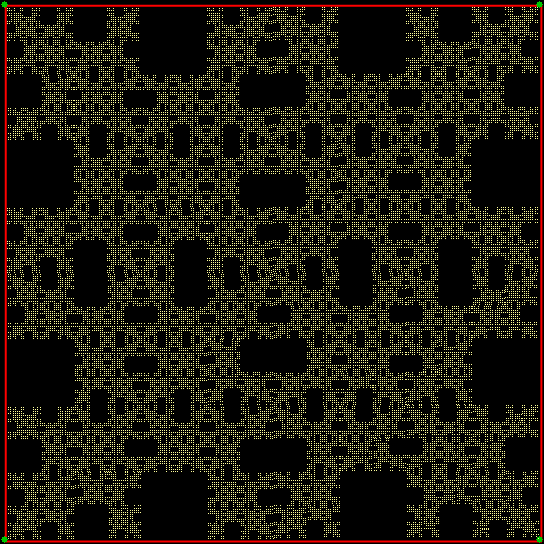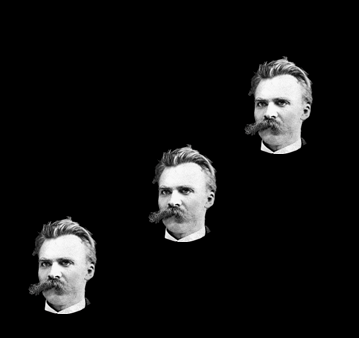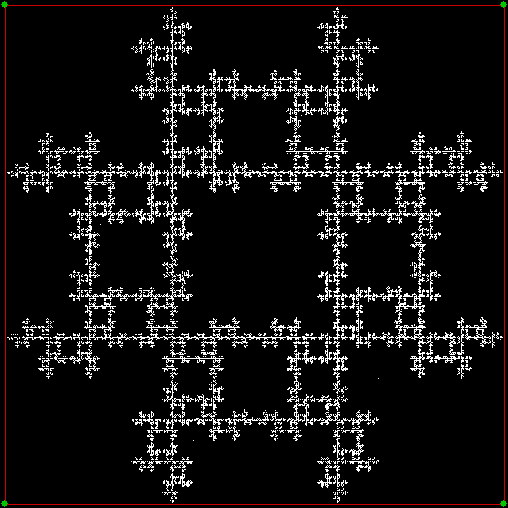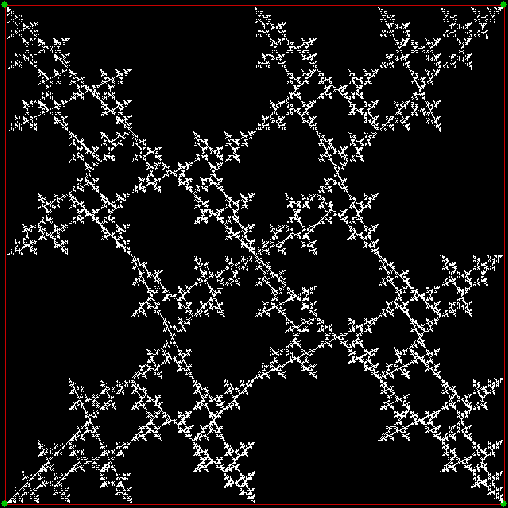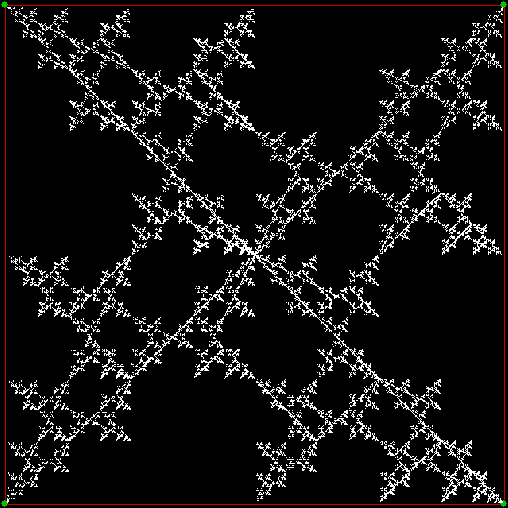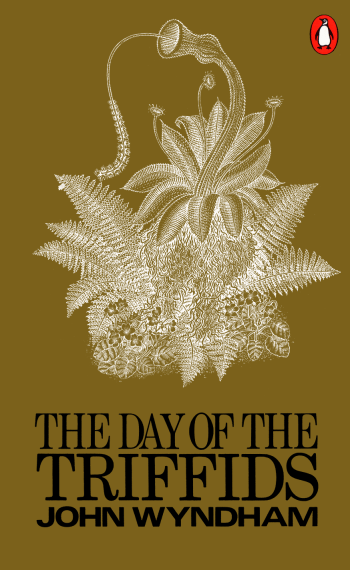In “Boole(b)an”, I looked at some of the things that happen when you impose bans of different kinds on a point jumping half-way towards a randomly chosen vertex of a square. If the point can’t jump towards the same vertex twice (or more) in a row, you get the fractal below (or rather, you get a messier version of the fractal below, because I’ve used an algorithm that finds all possible routes to create the fractals in this post):
ban = v(i) + 0
If the point can’t jump towards the vertex one place clockwise of the point it has just jumped towards, you get this fractal:
ban = v(i) + 1
If the point can’t jump towards the vertex two places clockwise (or anti-clockwise) of the point it has just jumped towards, you get this fractal:
ban = v(i) + 2
Finally, you get a mirror-image of the one-place-clockwise fractal when the ban is on jumping towards the vertex three places clockwise (or one place anti-clockwise) of the previous vertex:
ban = v(i) + 3
Now let’s introduce the concept of “vertex-history”. The four fractals above use a vertex-history of 1, vh = 1, because they look one step into the past, at the previously chosen vertex. Because there are four vertices, there are four possible previous vertices. But when vh = 2, you’re taking account of both the previous vertex, v(i), and what you might call the pre-previous vertex, v(i-1). There are sixteen possible combinations of previous vertex and pre-previous vertex (16 = 4 x 4).
Now, suppose the jump-ban is imposed when one of two conditions is met: the vertex is 1) one place clockwise of the previous vertex and the same as the pre-previous vertex; 2) three places clockwise of the previous chosen vertex and the same as the pre-previous vertex. So the boolean test is (condition(1) AND condition(2)) OR (condition(3) AND condition(4)). When you apply the test, you get this fractal:
ban = v(i,i-1) + [0,1] or v(i,i-1) + [0,3]
The fractal looks more complex, but I think it’s a blend of some combination of the four classic fractals shown at the beginning of this post. Here are more multiple-ban fractals using vh = 2 and bani = 2:
ban = [0,1] or [1,1]
ban = [0,2] or [2,0]
ban = [0,2] or [2,2]
ban = [1,0] or [3,0]
ban = [1,1] or [3,3]
ban = [1,2] or [2,2]
ban = [1,2] or [3,2]
ban = [1,3] or [2,0]
ban = [1,3] or [3,1]
ban = [2,0] or [2,2]
ban = [2,1] or [2,3]
For the fractals below, vh = 2 and bani = 3 (i.e., bans are imposed when one of three possible conditions is met). Again, I think the fractals are blends of some combination of the four classic ban-fractals shown at the beginning of this post:
ban = [0,0] or [1,2] or [3,2]
ban = [0,0] or [1,3] or [3,1]
ban = [0,0] or [2,1] or [2,3]
ban = [0,1] or [0,2] or [0,3]
ban = [0,1] or [0,3] or [1,1]
ban = [0,1] or [0,3] or [2,0]
ban = [0,1] or [0,3] or [2,2]
ban = [0,1] or [1,1] or [1,2]
ban = [0,1] or [1,1] or [3,0]
ban = [0,1] or [1,2] or [3,2]
ban = [0,2] or [1,0] or [3,0]
ban = [0,2] or [1,1] or [3,3]
ban = [0,2] or [1,2] or [2,2]
ban = [0,2] or [1,2] or [3,1]
ban = [0,2] or [1,2] or [3,2]
ban = [0,2] or [1,3] or [2,0]
ban = [0,2] or [1,3] or [3,1]
ban = [0,2] or [2,0] or [2,2]
ban = [0,2] or [2,1] or [2,3]
ban = [0,2] or [2,2] or [3,2]
ban = [0,3] or [1,0] or [2,0]
ban = [1,0] or [1,2] or [3,0]
ban = [1,0] or [2,2] or [3,0]
ban = [1,1] or [2,0] or [3,3]
ban = [1,1] or [2,1] or [3,1]
ban = [1,1] or [2,2] or [3,3]
ban = [1,1] or [2,3] or [3,3]
ban = [1,2] or [2,0] or [3,1]
ban = [1,2] or [2,0] or [3,2]
ban = [1,2] or [2,1] or [2,3]
ban = [1,2] or [2,3] or [3,2]
ban = [1,2] or [3,2] or [3,3]
ban = [1,3] or [2,0] or [2,2]
ban = [1,3] or [2,0] or [3,0]
ban = [1,3] or [2,0] or [3,1]
ban = [1,3] or [2,2] or [3,1]
ban = [2,0] or [3,1] or [3,2]
ban = [2,1] or [2,3] or [3,2]
Previously pre-posted
Boole(b)an — an early look at ban-fractals

